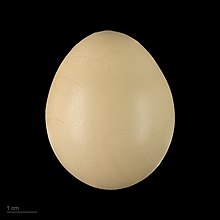Elliot's pheasant
| Elliot's pheasant | |
|---|---|

| |
| Scientific classification | |
| Domain: | Eukaryota |
| Kingdom: | Animalia |
| Phylum: | Chordata |
| Class: | Aves |
| Order: | Galliformes |
| Family: | Phasianidae |
| Genus: | Syrmaticus |
| Species: | S. ellioti
|
| Binomial name | |
| Syrmaticus ellioti (Swinhoe, 1872)
| |
| Synonyms [2] | |
| |

Elliot's pheasant (Syrmaticus ellioti), is a large pheasant native to south-eastern China.
Description
Males are up to 80 cm (31 in) long; they are brown and white with a black throat, chestnut brown upper parts, white belly, nape and wing bars, red bare facial skin and long rusty-barred whitish tail. Females are smaller, at 50 cm (20 in) long; they are rufous-brown with a blackish throat, whitish belly and less barred tail.[3]
Distribution
Elliot's pheasant is endemic to south-eastern China (Guizhou, Hubei, Anhui, Zhejiang, Fujian, Jiangxi, Hunan, Guangxi and Guangdong provinces), where it lives in evergreen and mountain forests at altitudes of 200–1,900 m (660–6,230 ft).[1] Its diet consists mainly of seeds, leaves and berries.[4]
Taxonomy
Elliot's pheasant was first described in 1872 by Robert Swinhoe, under the name "Phasianus ellioti"; the type material was from Ningpo, Zhejiang province, China.[2][5] The specific epithet ellioti commemorates the American ornithologist Daniel Giraud Elliot;[6][7] Swinhoe explained his choice thus:
- "Possessed of so many striking characteristics, it would be easy to find an appropriate name for so marked a species ; but on glancing down the list of Pheasants I find that not one bears the name of Elliot ; and it strikes me it would be wrong to allow his magnificent work on the subject to close without the figure of a bird dedicated to himself"[5] Alternative common names for the species include Chinese bar-backed pheasant[4] and Chinese barred-backed pheasant.[1]
Conservation
Although there is ongoing habitat loss, and the species has a limited range and is hunted for food, Elliot's pheasant is evaluated as Near Threatened on the IUCN Red List of Threatened Species, as it does not appear to be declining appreciably in numbers.[1] It is listed on Appendix I of CITES.[1]
See also
References
- ^ a b c d e Template:IUCN
- ^ a b "Elliot's Pheasant (Syrmaticus ellioti)". Pheasants and Partridges (Phasianidae). The Internet Bird Collection. Retrieved May 9, 2012.
- ^ "Elliot's Pheasant Syrmaticus ellioti". Species Factsheet. BirdLife International. Retrieved May 9, 2012.
- ^ a b "Elliot's pheasant (Syrmaticus ellioti)". ARKive. Retrieved May 9, 2012.
- ^ a b R. Swinhoe (1872). "Descriptions of two new Pheasants and a new Garrulax from Ningpo, China". Proceedings of the Zoological Society of London. 40 (1): 550–554. doi:10.1111/j.1469-7998.1872.tb07924.x.
- ^ Bo Beolens; Michael Watkins; Michael Grayson (2009). "Elliot, D.". The Eponym Dictionary of Mammals. Johns Hopkins University Press. p. 124. ISBN 9780801893049.
{{cite book}}: Unknown parameter|last-author-amp=ignored (|name-list-style=suggested) (help) - ^ James A. Jobling (2009). Helm Dictionary of Scientific Bird Names. A&C Black. p. 145. ISBN 9781408125014.
External links
 Data related to Syrmaticus ellioti at Wikispecies
Data related to Syrmaticus ellioti at Wikispecies- Elliot's Pheasant, gbwf.ord

